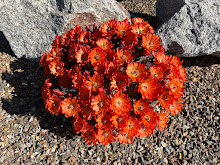Imagine my dismay when I saw this. Maybe dismay is not a strong enough adjective. Horror would be more like it.
What have I done? I covered the plant with shade cloth as soon as I got home from a month-long absence. It had been without water for 5 weeks. When I took off the cloth a week later this is what I saw. Confederate rose agave may be touted for its drought tolerance but coupled with 100° temperatures day after day it shows its displeasure. This on top of the hail that dinged it in the spring.
My immediate thoughts were that it was a total loss. After all those years of patiently waiting for it to reach such a beautiful cluster. ( This agave is well known for producing offsets which cluster beautifully around the mother plant)
But wait. A good watering and one week later things are looking better. The plant has a reprieve.
It will never lose the scars along the edges where it was burnt to a crisp but I believe it will make a good recovery and will live to spend another year on the pedestal.
Interestingly, this week there was an article in Gardening Gone Wild, by Debra Lee Baldwin, about stress and succulents. She highlighted several succulents which take on a rosy color when stressed. Euphorbia tirucalli, Sticks of Fire, is one of those, although the one I have has never graced me with such color. She does go on to say that this coloration does not happen among agaves so I think water saved this plant in the nick of time.
Read This: Gardening on the Dry Side of Texas
13 hours ago





























14 comments:
What a relief! I wish all plants looking to be dying could be so easily revived! (It's actually quite incredible the more I look at it...)
I'm so glad it recovered--that would have been a terrible loss. Hopefully you are heading into cooler temps??
I wanted to thank you so much for your comment on my blog----I hit the wrong button and deleted it by accident--so very sorry about that. I guess I shouldn't be reading comments at 4 in the morning.
Oh, this is timely. I did the same thing to a King Ferdinand agave. I only hope mine recovers from that same sun-fried color. Happy for you!
Good to know.
I never would have believed it possible, I'm filing this one away for future disasters. So happy for you!
Plants can be so forgiving!
nice save.
An amazing recovery!
So glad it worked out.
It's interesting that Debra says sun/drought coloration never happens with agaves, because I could swear Greg Starr talked about at least a couple of species that do that in his wonderful book Agaves. Have you read it? http://www.penick.net/digging/?p=16807
Succulents and cactus are the most forgiving of plants, Alan. Except when ht by hail. I am still pondering about what to do with those that suffered the worst.
I bet it will Denise. Here's hoping you have the same great recovery.
Surely you will never have 2 months with no rain and 100° heat in Portland.
No I haven't read that book. I wonder which ones they are? Need to take a look. On a different subject Debra also said that the decollate snail was not harmful to plants. She was most surely wrong about that. I do agree it has to do with the plants you might be growing.
Glad it was saved! Such a beautiful cluster, too! That is impressive it lasted so long. That is quite some succulent superpower!
Post a Comment